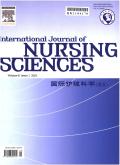上海市社区护士对临终病人护理态度的横断面研究
IF 3.1
3区 医学
Q1 NURSING
引用次数: 0
摘要
目的了解上海市社区护士对临终病人的护理态度及影响因素。方法于2023年8 - 11月对上海市社区护士进行方便抽样调查。采用人口统计学问卷、Frommelt临终关怀态度量表- b (FATCOD-B)和应对死亡量表(CDS)进行数据收集。数据分析采用独立样本t检验、单因素方差分析和多元线性回归分析。结果共1396名社区护士参与本研究。社区护士FATCOD-B总分为102.27±10.23分,其中关怀临终者家庭维度得分最高(4.03±0.53)分,沟通维度得分最低(2.86±0.52)分。总CDS评分为130.78±20.25。多元线性回归分析显示,死亡应对能力和混合死亡教育占社区护士临终关怀态度方差的13.7%。结论上海市社区护士对临终病人的护理态度较为温和。死亡应对能力越强的护士和参加过混合死亡教育的护士对临终病人的态度越积极。这些发现强调了混合死亡教育作为提高社区卫生服务中心临终关怀质量的实用策略的潜力。本文章由计算机程序翻译,如有差异,请以英文原文为准。
Attitudes toward caring for terminally ill patients among community nurses in Shanghai: A cross-sectional study
Objectives
This study aimed to evaluate attitudes toward caring for terminally ill patients and identify the associated factors among community nurses in Shanghai.
Methods
The study was conducted among community nurses using convenience sampling in Shanghai between August and November 2023. The demographic questionnaire, the Frommelt Attitude Toward Care of the Dying Scale-B (FATCOD-B), and the Coping with Death Scale (CDS) were used for data collection. Data analysis was conducted using independent sample t-test, one-way analysis of variance, and multiple linear regression analysis.
Results
A total of 1,396 community nurses participated in this study. The overall FATCOD-B score among community nurses was 102.27 ± 10.23, the attitude toward caring for the dying person’s family dimension scored the highest (4.03 ± 0.53), whereas the attitude toward the communication dimension scored the lowest (2.86 ± 0.52). The overall CDS score was 130.78 ± 20.25. Multiple linear regression analysis showed that death coping ability and blended death education accounted for 13.7 % of the variance in community nurses’ attitudes toward caring for terminally ill patients.
Conclusions
Community nurses in Shanghai exhibit moderate attitudes toward caring for terminally ill patients. Nurses with greater death coping ability and those who participated in blended death education tended to have more positive attitudes toward terminally ill patients. These findings underscore the potential of blended death education as a practical strategy to enhance hospice care quality in community health service centers.
求助全文
通过发布文献求助,成功后即可免费获取论文全文。
去求助
来源期刊

International Journal of Nursing Sciences
Nursing-Nursing (all)
CiteScore
6.10
自引率
2.60%
发文量
408
审稿时长
25 days
期刊介绍:
This journal aims to promote excellence in nursing and health care through the dissemination of the latest, evidence-based, peer-reviewed clinical information and original research, providing an international platform for exchanging knowledge, research findings and nursing practice experience. This journal covers a wide range of nursing topics such as advanced nursing practice, bio-psychosocial issues related to health, cultural perspectives, lifestyle change as a component of health promotion, chronic disease, including end-of-life care, family care giving. IJNSS publishes four issues per year in Jan/Apr/Jul/Oct. IJNSS intended readership includes practicing nurses in all spheres and at all levels who are committed to advancing practice and professional development on the basis of new knowledge and evidence; managers and senior members of the nursing; nurse educators and nursing students etc. IJNSS seeks to enrich insight into clinical need and the implications for nursing intervention and models of service delivery. Contributions are welcomed from other health professions on issues that have a direct impact on nursing practice.
 求助内容:
求助内容: 应助结果提醒方式:
应助结果提醒方式:


